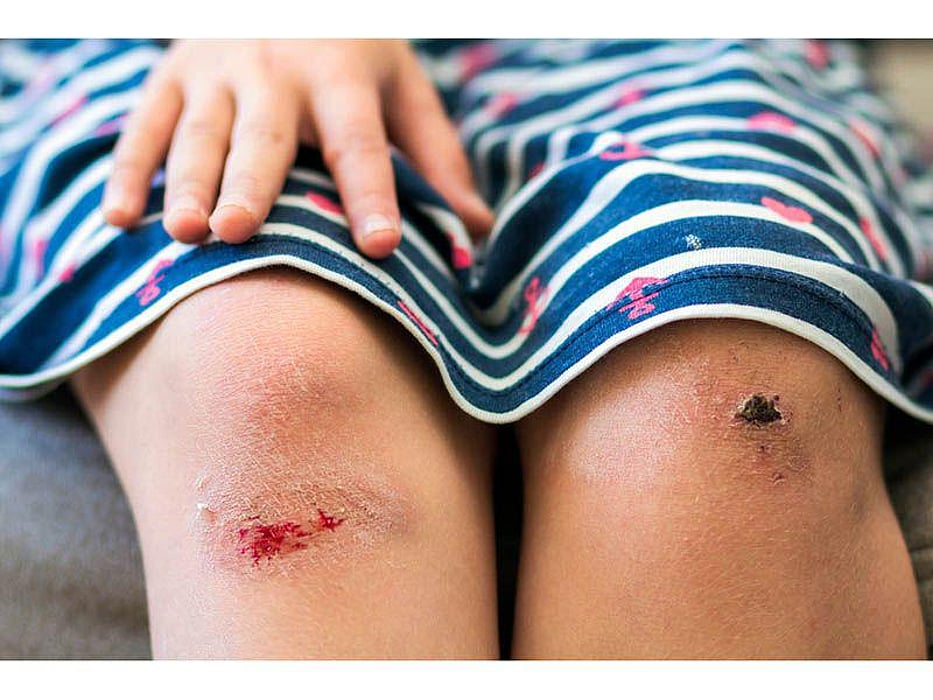Cuts and Scrapes (Children)

What's the best way to treat a cut or scrape?
If the cut or scrape is deep and bleeding, apply pressure with a clean cloth, paper towel, or bandage to stop the bleeding. If the bleeding doesn't stop in 10 minutes, call your child's physician immediately or go to the nearest emergency room. If the cut appears to need stitches, call your pediatrician. It's also wise to call your child's doctor about cuts to the face, since all but the most minor can cause visible scarring. If your child has been bitten by an animal or another child, she'll need special treatment. If your child has not had a tetanus booster within the last five years, call her doctor.
How do I know if a cut needs stitches?
Cuts that are more than a quarter inch deep, have jagged edges, or gape open usually require stitches. So do cuts on the face, eyelids, lips, or the palm side of the hand or fingers, where skin is taut or stretches with movement. For best results, cuts should be sutured within eight hours -- preferably sooner -- to avoid serious risk of infection and help prevent scarring. For cuts caused by dirty objects or for deep puncture wounds, your pediatrician may recommend a tetanus booster.
What should I do for less serious cuts and scrapes?
Make sure no glass, dirt, or other foreign material remains in the wound. If you see anything, use cool running water to flush it out. If that doesn't work, use tweezers to carefully remove the foreign object. Stop any bleeding by applying direct pressure with a clean bandage or towel. After the bleeding stops, gently wash the wound with soap and water for five minutes. If your child strenuously objects, try soaking the wound in the bathtub.
Should I use an antiseptic?
Antibiotic ointments such as Polysporin or Bacitracin can help reduce the risk of infection. Don't use rubbing alcohol, hydrogen peroxide, iodine, or mercurochrome: They're painful and may actually slow healing.
What's the best way to bandage a cut or scrape?
For cuts and scrapes, use an ordinary adhesive bandage, but make sure the skin is clean and dry.
If you're covering a cut, position the bandage to gently pull the edges of the skin together. But also make sure the bandage isn't so tight that it cuts off circulation. Remove it daily to examine how the wound is healing. Replace the bandage if the skin still looks raw or open.
After a scab forms on a scrape or a cut closes up, you no longer need a bandage. If your child has a tendency to pick at scabs, however, you may want to keep using a bandage to protect the area.
If the injury becomes swollen, tender, or infected, call your pediatrician or family doctor.
How can I ease the pain?
Give your child acetaminophen or ibuprofen, and follow the dosage instructions on the label.
References
Robert H. Pantell M.D., James F. Fries M.D., Donald M. Vickery M.D., Taking Care of Your Child: A Parent's Illustrated Guide to Complete Medical Care. Da Capo Press.
American Academy of Pediatrics. Treating Cuts. http://www.healthychildren.org/English/health-issu...
Image credit: Shutterstock
Related Posts
Prevalence of Concurrent HIV, STIs High in Persons With Monkeypox
THURSDAY, Sept. 8, 2022 (HealthDay News) -- Among persons with monkeypox, those...
Health Highlights: Sept.19, 2022
Tea might lower your odds for diabetes. In new study, drinking four or more cups...
Pfizer Asks FDA to OK COVID-19 Vaccine for Under 5s
THURSDAY, June 2, 2022 (HealthDay News) -- Pfizer Inc. said Wednesday that it...
